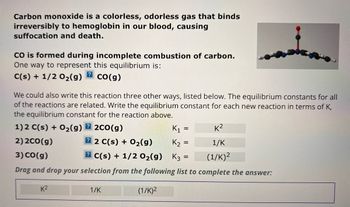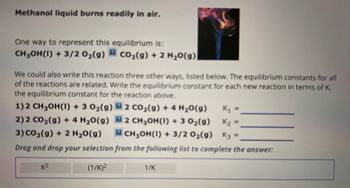
Chemistry
10th Edition
ISBN: 9781305957404
Author: Steven S. Zumdahl, Susan A. Zumdahl, Donald J. DeCoste
Publisher: Cengage Learning
expand_more
expand_more
format_list_bulleted
Question
thumb_up100%

Transcribed Image Text:Carbon monoxide is a colorless, odorless gas that binds
irreversibly to hemoglobin in our blood, causing
suffocation and death.
CO is formed during incomplete combustion of carbon.
One way to represent this equilibrium is:
?
C(s) + 1/2O₂(g) CO(g)
We could also write this reaction three other ways, listed below. The equilibrium constants for all
of the reactions are related. Write the equilibrium constant for each new reaction in terms of K,
the equilibrium constant for the reaction above.
1) 2 C(s) + O₂(g) 2 2c0(g)
K₁
2)2CO(g)
22 C(s) + O₂(g)
K₂ =
3) CO(g)
2 C(s) + 1/2O₂(g)
K3 =
Drag and drop your selection from the following list to complete the answer:
K²
1/K
(1/K)²
=
K²
1/K
(1/K) ²

Transcribed Image Text:Methanol liquid burns readily in air.
One way to represent this equilibrium is:
CH₂OH(1) + 3/2 0₂(g) CO₂(g) + 2 H₂O(g)
We could also write this reaction three other ways, listed below. The equilibrium constants for all
of the reactions are related. Write the equilibrium constant for each new reaction in terms of K,
the equilibrium constant for the reaction above.
1) 2 CH₂OH(1) + 3 O₂(g)
2) 2 CO₂(g) + 4H₂O(g)
2 CO₂(g) + 4H₂O(g)
2 CH₂OH(1) + 3 O₂(g)
CH₂OH(1) + 3/2 0₂(g) K3
K₁ =
K₂ =
3) CO₂(g) + 2 H₂O(g)
Drag and drop your selection from the following list to complete the answer:
K²
(1/K)²
1/K
Expert Solution
This question has been solved!
Explore an expertly crafted, step-by-step solution for a thorough understanding of key concepts.
Step by stepSolved in 4 steps with 4 images

Knowledge Booster
Learn more about
Need a deep-dive on the concept behind this application? Look no further. Learn more about this topic, chemistry and related others by exploring similar questions and additional content below.Similar questions
- 10 The equilibrium reaction of 2 moles of SOe) plus 1 mole of Oxe) produces 1 mole of SO3(g)- What is the equilibrium constant expression for this reaction. 2(g)arrow_forwardA mixture of 0.578 moles of carbon monoxide and 0.443 moles of oxygen was placed into a rigid 1.00-L container and the system was allowed to come to equilibrium at a certain temperature. The equilibrium concentration of CO2 was 0.239 M. What is the value of Ke for this reaction at this particular temperature? CO(g) + O2(g) = CO2(g) Report your answer to three significant figures and do not include units.arrow_forwardWrite the equilibrium constant expression. Solid carbon and carbon dioxide gas react and form carbon monoxide: C(s) + CO₂(g) = 2CO(g)arrow_forward
- 2. The compound NOCl decomposes to nitric oxide and chlorine according to the following equation: 2 NOCl (g) → 2 NO (g) + Cl2 (g) Suppose that 0.810 mol NOCl is placed in a 4.00-L flask at a given temperature. When equilibrium has been established, it is found that the concentration of Cl2 is 0.0105 M. Calculate the equilibrium constant for this reaction.arrow_forwardConsider the following reaction: 2 AB(g) = 2 A(g) + B2(g) The reaction is allowed to proceed until equilibrium is reached, and the final concentrations are: [AB] = 0.041 M [A] = 0.061 M [B2] = 0.030 M %3D %3D %3D Calculate the value of the equilibrium constant, K. Enter the numerical value using 2 significant figures.arrow_forwardAt a certain temperature, the equilibrium constant K for the following reaction is 0.0087: NO₂(g) + CO(g) → NO(g) + CO₂(g) Use this information to complete the following table. Suppose a 29. L reaction vessel is filled with 0.27 mol of NO₂ and 0.27 mol of CO. What can you say about the composition of the mixture in the vessel at equilibrium? What is the equilibrium constant for the following reaction? Round your answer to 2 significant digits. NO(g) + CO₂(g) NO₂(g) +CO(g) What is the equilibrium constant for the following reaction? Round your answer to 2 significant digits. 2 NO₂(g)+2CO(g) 2NO(g)+2CO₂(g) There will be very little NO₂ and Co. There will be very little NO and CO₂. Neither of the above is true. K = 0 0 0 x10 X ?arrow_forward
- A student ran the following reaction in the laboratory at 696 K: 2HI(g) H2(g) + I2(g) When he introduced HI(g) at a pressure of 3.40 atm into a 1.00 L evacuated container, he found the equilibrium partial pressure of HI(g) to be 2.68 atm. Calculate the equilibrium constant, Kp, he obtained for this reaction. Kp =arrow_forwardO KINETICS AND EQUILIBRIUM Using the general properties of equilibrium constants At a certain temperature, the equilibrium constant K for the following reaction is 380.: NO,(8) + CO(3) = NO(g) + CO,(3) Use this information to complete the following table. Suppose a 16. L reaction vessel is filled with 1.4 mol of NO, and 1.4 mol of CO. What can you say about the composition of the mixture in the vessel at equilibrium? There will be very little No, and CO. O There will be very little NO and CO,. O Neither of the above is true. What is the equilibrium constant for the following reaction? Be sure your answer has the correct number of significant digits. K = ] NO(9)+CO,(9) NO,(9)+CO(g) What is the equilibrium constant for the following reaction? Be sure your answer has the correct number of significant digits. K = ] %3D 3 NO,(9)+3CO(g) 3 NO(g)+3CO,(9) 1L Explanation Check IIIarrow_forwardConsider the following reaction: CO2(g) + C(graphite) = 2 CO(g) A reaction mixture initially contains 0.56 atm CO2 and 0.32 atm CO. If the equilibrium pressure of CO gas is 0.83 atm, find the equilibrium constant (Kp) for the reaction.arrow_forward
- When 0.16 mol of O2 gas and excess graphite were placed in a 2.00-L container and come to equilibrium, the concentration of CO gas was 0.088 0.024 M. What is the equilibrium constant, Kc, for this reaction at this temperature? Please report 4 decimal places, without units. C(s) + O2(g) ⟷ 2CO(g)arrow_forwardThe equilibrium constant for the following reaction is 49 at 450 °C. If 0.22 mole of I2 , 0.22 mole of H2 , and 0.66 mole of HI were put into an evacuated 1.00-liter container, would the system be at equilibrium? If not, what must occur to establish equilibrium? H2 (g) + I2 (g) = 2HI (g)arrow_forward
arrow_back_ios
arrow_forward_ios
Recommended textbooks for you
 ChemistryChemistryISBN:9781305957404Author:Steven S. Zumdahl, Susan A. Zumdahl, Donald J. DeCostePublisher:Cengage Learning
ChemistryChemistryISBN:9781305957404Author:Steven S. Zumdahl, Susan A. Zumdahl, Donald J. DeCostePublisher:Cengage Learning ChemistryChemistryISBN:9781259911156Author:Raymond Chang Dr., Jason Overby ProfessorPublisher:McGraw-Hill Education
ChemistryChemistryISBN:9781259911156Author:Raymond Chang Dr., Jason Overby ProfessorPublisher:McGraw-Hill Education Principles of Instrumental AnalysisChemistryISBN:9781305577213Author:Douglas A. Skoog, F. James Holler, Stanley R. CrouchPublisher:Cengage Learning
Principles of Instrumental AnalysisChemistryISBN:9781305577213Author:Douglas A. Skoog, F. James Holler, Stanley R. CrouchPublisher:Cengage Learning Organic ChemistryChemistryISBN:9780078021558Author:Janice Gorzynski Smith Dr.Publisher:McGraw-Hill Education
Organic ChemistryChemistryISBN:9780078021558Author:Janice Gorzynski Smith Dr.Publisher:McGraw-Hill Education Chemistry: Principles and ReactionsChemistryISBN:9781305079373Author:William L. Masterton, Cecile N. HurleyPublisher:Cengage Learning
Chemistry: Principles and ReactionsChemistryISBN:9781305079373Author:William L. Masterton, Cecile N. HurleyPublisher:Cengage Learning Elementary Principles of Chemical Processes, Bind...ChemistryISBN:9781118431221Author:Richard M. Felder, Ronald W. Rousseau, Lisa G. BullardPublisher:WILEY
Elementary Principles of Chemical Processes, Bind...ChemistryISBN:9781118431221Author:Richard M. Felder, Ronald W. Rousseau, Lisa G. BullardPublisher:WILEY

Chemistry
Chemistry
ISBN:9781305957404
Author:Steven S. Zumdahl, Susan A. Zumdahl, Donald J. DeCoste
Publisher:Cengage Learning

Chemistry
Chemistry
ISBN:9781259911156
Author:Raymond Chang Dr., Jason Overby Professor
Publisher:McGraw-Hill Education

Principles of Instrumental Analysis
Chemistry
ISBN:9781305577213
Author:Douglas A. Skoog, F. James Holler, Stanley R. Crouch
Publisher:Cengage Learning

Organic Chemistry
Chemistry
ISBN:9780078021558
Author:Janice Gorzynski Smith Dr.
Publisher:McGraw-Hill Education

Chemistry: Principles and Reactions
Chemistry
ISBN:9781305079373
Author:William L. Masterton, Cecile N. Hurley
Publisher:Cengage Learning

Elementary Principles of Chemical Processes, Bind...
Chemistry
ISBN:9781118431221
Author:Richard M. Felder, Ronald W. Rousseau, Lisa G. Bullard
Publisher:WILEY